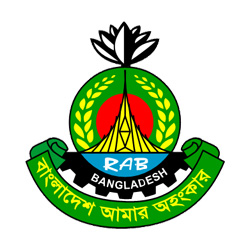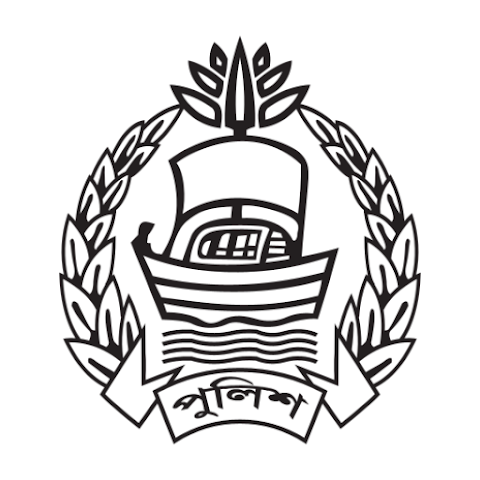পটভূমি
About Department of Fisheries
Since the inception of the then East Pakistan (now Bangladesh) the DoF has had continuing as a front line public sector organization for fisheries development. After the independence of Bangladesh in 1971 the Central Fisheries Department of the then Pakistan was merged with the DoF of Bangladesh in April 1975. Later on in 1984 Central Marine Fisheries Dept. was merged with the DoF as a Marine Fisheries wing.
Organization in brief
DoF is under the administrative control of the Ministry of Fisheries and Livestock. It is headed by a Director General, who is assisted by an Additional Director General, sixteen Directors (including reserve) and 2 Principal Scientific Officer (equivalent to Director). There are 6065 technical officers of different stairs and supporting staffs in the DoF. They render their services to achieve the mission and vision of the DoF. There are administrative set-ups at division, district and Upazila (sub-district) levels headed by Director, Deputy Director, District Fisheries Officer and Senior/Upazila Fisheries Officer respectively. Besides these, there are three fish inspection and quality control stations under DoF. Furthermore DoF also comprises of Marine Fisheries Station, Fisheries Training Academy, Fisheries Training and Extension Centers, and Fish Hatcheries.
Mandate
- To disseminate improved aquaculture technologies through training and demonstration and to extend extension advisory services to the focal stakeholders.
- To enhance fisheries resources through enacting conservation and management measures.
- To assist the administrative ministry to formulate policies, acts etc.
- To enforce quality control measures and issuance of health certificates for exportable fish and fish products.
- To conduct fisheries resources survey and assessment of stock to develop fisheries database for proper planning.
- To facilitate arrangement for institutional credit for fish and shrimp farmers, fishers and fish traders and entrepreneurs.
- To facilitate alternative income generating activities for rural poor and unemployed people towards poverty alleviation.
- To formulate and implement development projects /programs towards sustainable utilization of fisheries resources to ensure food security.
To disseminate improved aquaculture technologies through e-Extension service
Sister Organisation
a. Bangladesh Fisheries Research Institute (BFRI)(www.fri.gov.bd)
BFRI is an autonomous organization under the Ministry of Fisheries and Livestock. This institute had been established in 1984. Under this institute there are 6 stations located at Mymensingh, Chandpur, Rangamati, Cox's Bazar, Bagherhat and Paikgacha (Khulna); and four substations at Santahar, Jessore, Barisal and Saidpur. These stations conduct basic and applied research on freshwater aquaculture, inland fisheries management, lake management, fish diseases, marine fisheries, brackish water aquaculture, fish breeding genetics etc. Some of the technologies innovated by this institute are being disseminated to the fields by DoF.
b. Bangladesh Fisheries Development Corporation (BFDC)(www.bfdc-gov.org)
BFDC is also an autonomous organization under the Ministry of Fisheries and Livestock. This corporation had been established in 1964. BFDC is mainly involved in harvesting fisheries resources and developing marketing facilities in the country. BFDC has established fish harbors, landing and distribution centers, ice plants and processing plants in several locations of Bangladesh. In the past, BFDC played a vital role in supplying safe and quality fish in the domestic market.
c. Marine Fisheries Academy (www.mfa-mofl.net)
The Academy was established in 1973 with the technical assistance from former USSR to maintain proper and optimum management of sea fishes through developing expertise for Marine Fisheries. Ti is entrusted to train cadets skillful through modern techniques and equipments, in order to meet the challenges of millennium in shipping sectors. On completion of three years training in the academy qualified cadets are awarded with BSC (pass) degree from National University.
d. Fisheries and Livestock Information Department (FLID) (www.flif.gov.bd)
FLID is established in 1986 under the Ministry of Fisheries and Livestock which has four branches in Dhaka, Rajshahi, Barisal and Comilla. This department of many booklets and leaflets to transfer latest technologies and update information regarding the development activities in the fisheries and livestock sectors. A monthly bulletin is also published from FLID which have many update news, technology and information about fisheries and livestock development activities.
Fisheries Sector: Prospects and Potentials
a. National Contribution
Fisheries sector contributed 2.43% to national GDP and 22.14% to the agricultural GDP and 1.05% to foreign exchange earnings by exporting fish and fish products in 2021-22. Fish provides 67.80% of national animal protein consumption. Fisheries sector also plays an important role in rural employment generation and poverty alleviation.
b. Source of Fish Production
There are three categories of major fisheries resources, these are-
- Inland Capture (27.78%)
- Inland Culture (57.39%)
- Marine Capture (14.83%)
c. Inland Fisheries
Inland fisheries comprises of rivers, ponds, estuaries, beels, floodplains, haors, baors, brackish water etc. There are 260 fish and 24 prawn species in inland fresh water in the country. In early sixties inland fisheries contributed about 90% of total fish production of the country. Fish production from aquaculture has increased to a great extent but open water fish production is in slow progress. Now only about 27.78% of total fish production comes from inland open water.
d. Marine Fisheries
The Bay of Bengal is situated in the South of Bangladesh. There is a total of 1,18,813 sq. km. water area including Exclusive Economic Zone (EEZ). Fishing is only confined within 200-meter depth. About 263 (active 233) trawlers, 29358 mechanized and artisonal vessels are engaged in fishing. Pelagic and deep-sea resources are still untapped. In the year 2021-22 total fish production from Marine source was 7.06 lac metric MT.
Recently Bangladesh has got the right to access 1.00 lac sq. kilometer water area in Bay of Bengal through International Tribunal for the Law of the Sea (ITLOS) by the visionary and pragmatic leadership of Honorable Prime Minister Sheikh Hasina. DoF has planned to assess the fisheries resources in the Bay of Bengal for maximum sustainable yield. A research vessel is under process of procurement to conduct appropriate stock assessment. Vessel Tracking Monitoring System will also be developed.
Last 5 years fish production is shown in the following table
|
Year |
Source-wise production (lakh MT) |
Total |
||
|
Inland open |
Closed |
Marine |
||
|
2021-2022 |
13.22 |
27.31 |
7.06 |
47.59 |
|
2020-2021 |
13.01 |
26.39 |
6.81 |
46.21 |
|
2019-2020 |
12.48 |
25.84 |
6.71 |
45.03 |
|
2018-2019 |
12.36 |
24.89 |
6.60 |
43.84 |
|
2017-2018 |
12.17 |
24.05 |
6.55 |
42.77 |
e. Fish production
In 2021-22 the total fish production is 47.59 lac Metric Ton (MT). The Production from closed water bodies is increasing very sharply due to dissemination of adaptive technologies and need-based extension services rendered by DoF.
Last 5 years Hilsa production is shown in the following table
|
Year |
Unit: lakh MT |
Growth rate(%) |
||
|
Inland (MT) |
Marine(MT) |
Total |
||
|
2021-2022 |
2.45 |
3.22 |
5.67 |
0.25 |
|
2020-2021 |
2.51 |
3.14 |
5.65 |
2.73 |
|
2019-2020 |
2.46 |
3.04 |
5.50 |
3.23 |
|
2018-2019 |
2.42 |
2.90 |
5.33 |
3.02 |
|
2017-2018 |
2.33 |
2.85 |
5.17 |
4.18 |
Major group wise contribution in fish production (2021-2022)
There are 260 freshwater and 475 marine fish species in the country. About 12 exotic species are being cultured in the country.
National Fisheries Policy
A national fisheries policy has been adopted to make the aquaculture and fisheries management activities environment friendly and sustainable. The policy has been formulated aiming at the primary objective of increasing fish production through optimum utilization of the available resources. In this policy a separate chapter containing shrimp culture and export guideline has been incorporated. National shrimp policy rule is under consideration of the government employment generation and poverty alleviation have also been given importance in fisheries policy. National Fisheries Strategy has been developed and approved by the Ministry of Fisheries and Livestock in 2006 on the basis of National Fisheries Policy. The Fisheries strategy comprises of 8 sub-strategies and action plan.
Development Activities
a. Annual Development Program
In addition to the normal activities of the DoF several development projects are being implemented aiming at boosting up fish production and conservation of fisheries resources. In 2021-2022 a total of 14, investment projects 12 and 2 technical assistance Project has been in implementation. technical assistance projects are being implemented. Through the development activities habitat restoration, conservation of natural resources, community based resource management, human resource development, and alternate income generating activities etc. is implementing in this sector.
c. Aquaculture Practices
i) Freshwater Aquaculture: Indian major carps and exotic carps are largely cultured in the country. Culture practices are mainly improved-extensive and semi-intensive. Beside Carp aquaculture, monoculture of Thi Pungus, Tilapia, Shorputi, Thai Koi are also practiced. Average fish production in the ponds is 5276 kg/ha/year. Freshwater prawn (m.rosenbergii) is also cultured along with carps in some areas of the country.
ii) Brackish Water Aquaculture: It is widespread in Satkhira, Khulna, Cox's Bazar and Bagerhat District. Tiger Shrimp p. monodon and giant prawn M. rosenbergii are the species of shellfish cultured in those areas. M. rosenbergii is largely cultured in southwest region of the country. The total production of shrimp and prawn farm in 2021-2022 was about 2.87 lac MT.
iii) Fish and shrimp Hatchery: Fish hatchery especially carp hatchery started to come up in late seventies. At present there are 874 private hatcheries, 110 Government fish Hatcheries (Including BFRI substation’s hatcheries) and 20,056 private nurseries in the country.
A total of 627586 kg spawn was produced from private and Government Hatcheries in the year 2021-22. Collection of fish seed from natural grounds has increased to about 1855 kg. In 2021-22 there were about 50 P.monodon (Bagda) Hatcheries and 39 M.rosenbergii (Galda) Hatcheries. About 83300 lac bagda post larva (PL) and about 672 lac golda post larvae (PL) were produced in these hatcheries. almost all Bagda Hatcheries are located in Cox's Bazar region, but major culture grounds are situated in southwest region of Bangladesh.
d. Open water management
ii) Hilsa Fishery Management: Hilsa (Shad) is an important diadromous fish in the South and south-East Asia especially in Bangladesh. It is considered as national fish in the country and contributes to the national economy, employment and export. Hilsa has the highest contribution in the country's fish production as the single fish species. Around 12% of the country's fish production comes from Hilsa. In 2021-22 Hilsa production was 5.67 lac MT, which values around 20,680 crore taka. DoF has taken some steps to strengthen the on-going Hilsa management through jatka Conservation Project/Program like (1) to establish 5 Hilsa sanctuaries, (2) to arrange need based training to involve the hilsa fishers for effective intervention of alternation income generating activities, and (3) to support the hilsa fishers with 30 kg food grains/family/month during the ban periods for four months. A total of 20 thousand fishers in Hilsa sanctuary areas are being directly benefited through Alternate Income Generation Activities.
iii) Halda river conservation and management
The Government declared Halda as “Bangabandhu Fisheries Heritage’’ to protect the unique ecosystem, which is the largest spawning ground for carp. DoF strictly implement the Fish Act in the Halda River. A total of 24 mobile courts, 82 expeditions was conducted to seize illegal net in the 2022-2023 FY, while 436.93 kg larvae were collected from 14664 kg spawn.
Fishermen registration
Department of Fisheries is continuing to register fishermen to identify genuine fishermen so that they can get government financial support, and AIG to improve their livelihood status. In the fiscal year of 2022-2023, a total of 106853 fishermen have newly registered in the database. So, the total number of registered fishermen up to June 2023 across the country was 1764154.
Integrated Natural Resource Management
The Department of Fisheries (DoF), Bangladesh plays a crucial role in integrated natural resource management. Here are some of the key steps taken by the Department of Fisheries:
- Open water fisheries management:
For open water fisheries management and conservation Department of Fisheries takes a number of initiatives, including fingerling stocking, beel nursery establishment, and fish sanctuary establishment every year.
- Fingerling stocking
Environmental degradation and anthropogenic activities continue to pose serious consequences to the fish biodiversity. Natural recruitment of carp spawn and fingerling is on a declining trend due to overfishing, illegal fishing practices, and climate-induced environmental changes. To offset the risk associated with depleted fish stock, Department of Fisheries started stocking of carp fingerling into open water bodies each year over the last few decades. It is usually done to increase fish production in open water bodies. In the fiscal year of 2022-2023, a total of 215.43 MT fingerlings had been stocked all across the country and the number of beneficiaries was 14.16 lakh.
- Beel Nursery
Beel nursery is usually established in the low laying areas of beels, which hold much of its waters during the season of high rainfall. The main objective of beel nursery establishment is to rear fish fingerlings until they are stocked in larger water bodies, such as beels, flood plains, rivers and so on. Establishment of beel nursery has been proved to be one of the most significant fish management practices for increasing fish production in open water bodies. Department of Fisheries has been executing this program since 2010. During the fiscal year of 2022-2023, around 1073 numbers of beel nurseries have been established throughout the country, which engage 6.54 lakh people.
- Establishment and management of fish sanctuary
A fish sanctuary is a protected area that is demarcated and declared as a no-fishing zone and provides shelter for broods and other fishes, particularly in the dry season. Fish sanctuary is typically established to protect fish populations from illegal fishing practices and other disturbances, thus increasing average fish production. During the last fiscal year (2022-23), nearly 389 fish sanctuaries were being managed by the local fishermen communities. There are 494 fish sanctuaries in different wetlands including the Halda River, which comprise 1430.69 hectares area. In addition, 6 Hilsha sanctuaries had been established to protect hilsha fish for natural propagation, totaling 432 km area.
- Dissemination of Improved Aquaculture Technologies:
- The DoF conducts training and demonstrations to share advanced aquaculture techniques with stakeholders.
- They provide extension advisory services to farmers and fishers to enhance productivity.
- Conservation and Management Measures:
- The DoF works to enhance fisheries resources by implementing conservation and management measures.
- These measures aim to sustainably utilize aquatic resources while protecting the environment.
- Policy Formulation and Implementation:
- The department assists the administrative ministry in formulating policies, acts, and regulations related to fisheries.
- They ensure adherence to quality control measures and issue health certificates for exportable fish and fish products.
- Department of Fisheries allocates a budget each year to implement the Fish Act for the conservation and management of fisheries resources. In FY 2022-23, a budget of 90.00 lakh taka was allocated to implement fish act in the haor region. Moreover, 52.00 lakh taka was spent to remove illegal dam and other permanent structure that might create any disturbance in the natural breeding grounds and fish habitats.
- Fisheries Resources Survey and Database Development:
- The DoF conducts surveys to assess fishery resources and stocks.
- This data helps in proper planning and sustainable resource utilization.
- Arrangement for Micro Credit:
- The department facilitates access to micro credit for fish farmers, fishers, and entrepreneurs.
- This supports the growth of the fisheries sector.
- Alternative Income Generation:
- The DoF promotes income-generating activities for rural communities, contributing to poverty alleviation.
- These initiatives empower the rural poor and unemployed.
- Development Projects for Food Security:
- They formulate and implement development projects to ensure food security through sustainable fisheries resource utilization.
- Collaboration with Sister Organizations:
Export of Fish & Fish Products
There are100 fish processing plants in the country. Out of 107 plants European Commission has approved 77 plants. HACCP has already been introduced in fish processing establishments. Major importing countries are European countries, USA and Japan. About 98% of total fish products are exported to those countries. Remaining are exported to the countries in Southeast Asia and Middle East.
|
Year |
Shrimp/Prawn |
Other fish products |
Total |
||
|
Quantity (MT) |
Value (Crore Taka) |
Quantity (MT) |
Value(Crore Taka) |
Value (Crore Taka) |
|
|
2021-22 |
30571.40 |
3636.59 |
43471.27 |
1555.17 |
5191.76 |
|
2020-21 |
30615.14 |
2730.56 |
45976.55 |
1358.41 |
4088.97 |
|
2019-20 |
30036.18 |
2948.94 |
40909.21 |
1036.21 |
3985.15 |
|
2018-19 |
33362.52 |
3088.85 |
39808.79 |
985.67 |
4074.52 |
|
2017-18 |
36167.77 |
3527.07 |
32767.95 |
782.87 |
4309.94 |
Fish Production and Resource Conservation Campaign
Campaign for boosting fish production and resource conservation fish week is being observed usually in between July and September every year. Raising awareness of the people through the country for the conservation and management of fisheries resources is also an objective of this campaign. It is a national program and is inaugurated by the Honorable Prime Minister of the Peoples Republic of Bangladesh.
FISHERIES RESOURCES INFORMATION ON BANGLADESH
(2021-2022)
|
Water Area |
|
|
|
|
|
(a) |
Closed Water Body (Culture based) |
845399 ha. |
|
|
|
i) Pond & Ditches : |
410683 ha. |
|
|
|
ii) Oxbow lake : |
5671 ha |
|
|
|
iii) Shrimp Farm : |
262980 ha |
|
|
(b) |
Open Water Body (Capture based) |
3860772 ha |
|
|
|
i) River & Estuaries (without Sundarban) |
8,53,863 ha |
|
|
|
ii) Beel |
1,14,161 ha |
|
|
|
iii) Kaptai Lake |
68,800 ha |
|
|
|
iv) Flood Plain : |
2646248 ha |
|
|
(c) |
Marine Fisheries |
|
|
|
|
i) Territorial Water : |
2,680 sq. n. miles |
|
|
|
ii) Exclusive Economic Zone : |
41,040 sq. n. miles |
|
|
|
iii) Continental Shelf |
24,800 sq. n. miles |
|
|
|
iv) Coast line : |
710 km. |
|
2. |
Fish Production |
4758731 mt. |
|
|
|
|
i) Open Water (capture) : |
1321631 mt. |
|
|
|
ii) Closed Water (Culture) : |
2731070 mt. |
|
|
|
iii) Marine Fisheries |
706030 mt. |
|
3. |
(a) |
Export of Fish & Fish Products |
|
|
|
|
i) Quantity |
74042.67 ton. |
|
|
|
ii) Value (BDT) |
5191.76crore |
|
|
|
iii) Contribution to export earning : |
1.05% |
|
|
(b) |
No. of Fish Processing Plants : |
107 |
|
|
(c) |
No. of EU approved Plants : |
77 |
|
4. |
Contribution in GDP |
2.08% |
|
|
5. |
Fish Intake/Demand |
|
|
|
|
|
i) Per capita Annual Fish Intake : |
21.90 kg. |
|
|
|
ii) Annual Total Fish Needed : |
42.38 lakh mt. |
|
|
|
|
|
|
|
|
iii) Contribution in Animal Protein supply : |
60% (App.) |
|
6. |
Fish Hatchery/Nursery |
|
|
|
|
|
i) Fish hatchery : |
984 (including Govt. (DOF) 102, Govt. (BFRI) 8 and Private 874) |
|
|
|
ii) No. of Fish Nursery : |
20,056 |
|
|
|
iii) Fingerling Production : |
923.49 crore (2021) |
|
|
|
|
|











